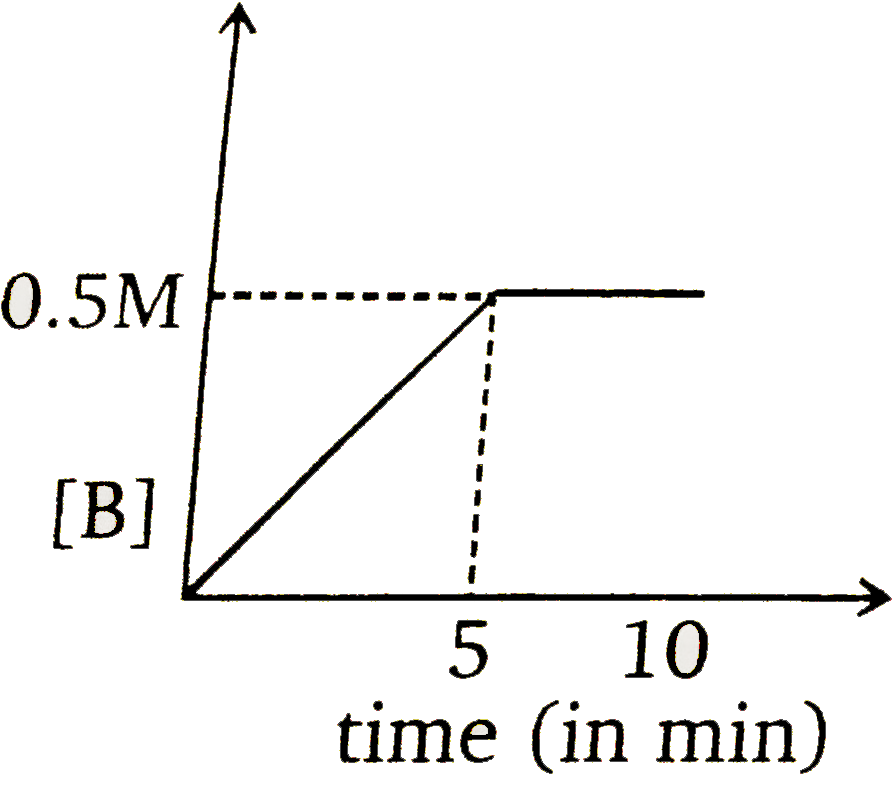Consider a reaction A(g)k=0.1M−1min−−−−−−−→2B(g). If initial concentration of A is 0.5 M then select correct graph.Solution in Telugu




The correct Answer is:C
Step by step video & image solution for Consider a reaction A(g)overset(k=0.1 M min^(-1))to2B(g). If initial concentration of A is 0.5 M then select correct graph. by Chemistry experts to help you in doubts & scoring excellent marks in Class 12 exams.
Updated on:21/07/2023Topper's Solved these Questions
- CHEMICAL KINETIC & NUCLEAR CHEMISTRYBOOK - NARENDRA AWASTHICHAPTER - CHEMICAL KINETIC & NUCLEAR CHEMISTRYEXERCISE - Level 1 (Q.3 To Q.32)
2 Videos
- CHEMICAL KINETIC & NUCLEAR CHEMISTRYBOOK - NARENDRA AWASTHICHAPTER - CHEMICAL KINETIC & NUCLEAR CHEMISTRYEXERCISE - Level 1 (Q.33 To Q.62)
3 Videos
- SURFACE CHEMISTRYBOOK - NARENDRA AWASTHICHAPTER - SURFACE CHEMISTRYEXERCISE - Level 3 - Assertion - Reason Type Questions
1 Videos
Similar Questions
The reaction of A2 and B2 follows the equation
A2(g)+B2(g)→2AB(g)
The following data were observed
[A2]0[B2]0Initial rate of appearance of AB(g)(inMs−10.100.102.5×10−40.200.105×10−40.200.2010×10−4
The value of rate constatnt for the above reaction is :
View SolutionHalf-life (t1/2) and completion time (T) of the reaction (A→2B) are if initial concentration A is 1M and k = 0.001M/ min :
View Solutioneach question constain STATEMENT-1(Assertion ) and STATEMENT - 2 (reason). examine the statement carefully and work the correct answer accoridng to the instructions given below :
STATEMENT-1: Dispersed phase particles of colloidal solution cannot pass through ultra -filter paper.
STATEMENT-2: The size of colloidal particles are larger than the size of true solution particles.
View SolutionA certain zero order reaction has k=0.025Ms−1 for the disappearance of A. What will be the concentration of A after 15 seconds if the initial concentration is 0.5M ?
View SolutionConsider a reaction A(g)k=0.1M−1min−−−−−−−→2B(g). If initial concentration of A is 0.5 M then select correct graph.
View SolutionThe kinetic date for the given reaction A(g)+2B(g)K−−→C(g) is provided in the following table for three experiments at 300 K Ex. No.[A/M][B/M]Initial rate(Msec−1)1.0.010.016.930×10−62.0.020.011.386×10−53.0.20.021.386×10−5<b>Ina¬herexperiment⋆t∈gswith∈itialconcentrationof0.5and1MrespectivelyforAandBat300K,f∈dtherateofreactionafter50minutesomthe⋆t∈gofedperiment(∈M//sec).
View SolutionA compound A dissociates by two parallel first order paths at certain temperature A(g)overset(k_(1)(min^(-1)))to2B(g)" " k_(1)=6.93xx10^(-3)min^(-1) A(g)overset(k_(1)(min^(-1)))toC(g)" " k_(2)=6.93xx10^(-3)min^(-1) The reaction is started with 1 mole of pure 'A' litre closed container with initial pressure 2 atm. What is the pressure (in atm) developed in container after 50 minutes from start of experiment?
View SolutionFor the reaction, A(g) rarr B(g) +C(g) Select the correct graph.
View SolutionThe rate law expresses the relationship of the rate of a reaction to the rate constant and the concentration of the reactants raised to some powers for the general reaction. aA+bBtocC+dD Rate law takes the form r=k[A]^(x)[B]^(y) where x and y are number that must be determined experimentely k is the rate constant and [A] and [B] are concentration of A & B respectively. The initial rate of zero order reaction of the gaseous equation A(g)to2B (g) is 10^(-2) M min^(-1) If the initial concentration of A is 0.1 M what would be concentration of B after 60 seconds ?
View SolutionThe half-life of a first order reaction is 30 min and the initial concentration of the reactant is 0.1 M. If the initial concentration of reactant is doubled, then the half-life of the reaction will be
View SolutionThe half life of a first order reaction is 30 min and the initial concentration of the reactant is 0.1 M . If the initial concentration of reactant is doubled ,then the half life of the reaction will be
View SolutionFor a gaseous reaction,
2A(g)+B(g)→C(g),ΔH=−30Kcal/mole at300K
If the reaction follows the rate law d[C]dt=4×10−3[A]2[B]M/min and initially concentration of Bis[B]=10−3M and concentration of A is [A]=1M, then calculate the rate at which heat will be liberated per minute initially if reaction occurs in a rigid container of volume 10 litres.
[Express answer in 10−1cal/min]
[Use:R=2cal/molK]
View SolutionFor the reaction 3A(g)k−−→B(g)+C(g) k is 10−4L/mol.min.
If [A] = 0.5M then the value of −d[A]dt(in ms−1 is:
View SolutionFor A→B, a first order reaction, k=10−2min−1. If initial concentration of A is 1M, rate of the reaction after 2.31 hrs will be (in M-min−1)
View SolutionConsider a reaction A(g)k=0.1M−1min−−−−−−−→2B(g). If initial concentration of A is 0.5 M then select correct graph.
View SolutionThe kinetic date for the given reaction A(g)+2B(g)K−−→C(g) is provided in the following table for three experiments at 300 K
Ex. No.[A/M][B/M]Initial rate(Msec−1)1.0.010.016.930×10−62.0.020.011.386×10−53.0.20.021.386×10−5
In another experiment starting swith initial concentration of 0.5 and 1 M respectively for A and B at 300 K, find the rate of reaction after 50 minutes from the starting of edperiment (inM/sec).
View Solution
